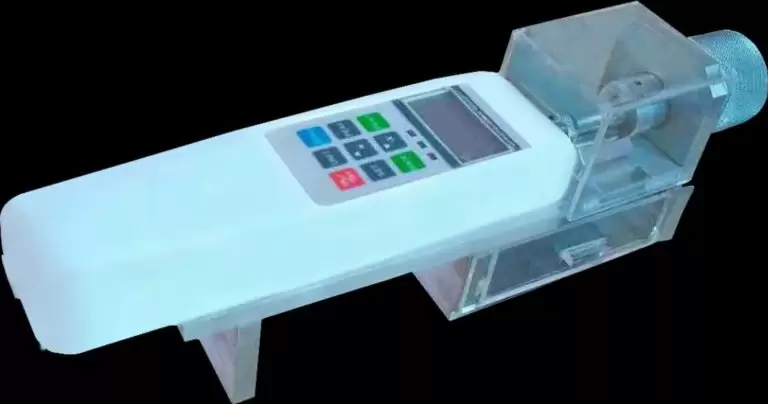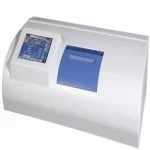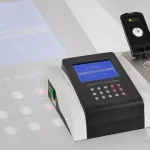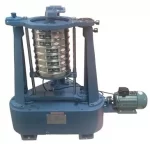Tablet Hardness Tester

Handheld Model of Hardness Tester/ Tablet hardness tester
Tablet hardness testers, hardness testers, tablet testers, or any name that may refer to them are critical Pharmaceutical instruments for any research laboratory. You can use the instrument to test plain, delayed, and coated tablets. Tablet hardness tests work on the basis that a certain amount of force is required to break the tablet. The tablet hardness tester is used to measure the crushing hardness of tablets.
- Automatically Process.
- High Accuracy
- High-precision pressure sensor. Hardness data is displayed on the LED.
- Tablet hardness testers are tools for detecting the breaking hardness of the tablet.

This force is registered in Newton and is the value of the hardness of the tablet. The figure is what laboratory technicians use to establish quality control and compliance. Most tablet hardness testers are work by simply moving the jaw or rod that presses the tablet between two hard plates. Thus, causing it to break under pressure and, consequently, establish the necessary force. There are several different tablet hardness testers that work on the same primary principle. Hardness testers range from simple manual equipment to fully automated devices.
HARDNESS TEST INSTRUMENT FOR TABLET:
Physical testing of tablets, their width, length, weight, thickness, disintegration time, and hardness, is time-consuming. Automatic tablet hardness testing systems are more accurate and productive, which saves time and money and frees you from a very tedious task. Tablet hardness testing equipment mixes the measurement of physical parameters with thickness, weight, diameter, and hardness. Yatherm Scientific provide hardness tester for tablet samples of different shapes and sizes, without the need to change the settings between products. You can set all the information that the hardness tester needs to know in the profile of the saved product. Starting the tablet hardness testing process involves a few simple ways and then the hardness testing machine performs the tests accurate result.
Pharmaceutical production is increasingly competitive. The ability to ensure consistent quality, to minimize direct production costs, and to analyze test results immediately can be essential to maintain a competitive advantage. Increasing the efficiency of physical test operations by investing in a high-quality tablet hardness testing machine will help you save on costs and maintain a competitive advantage.
OPERATION OF A TABLET HARDNESS TESTER:
The operation of most tablet hardness testing equipment can be broken down into a major movement of the jaw or rod that presses the tablet between two plates. This forces the tablet to break under pressure and thus establish the required strength. When performing a tablet hardness test, place the tablet between the two jaws. One of which is connected to a load cell and the rest to the motor, which offers the mechanical drive. The motorized jaw is directed forward, compressing the tablet against the stationary jaw until the tablet cracks. In the event of a breakage, the motorized plate retracts and the device records the force required to break the tablet.
GENERAL METHODS FOR TESTING THE HARDNESS OF TABLETS INCLUDE:
- CRUSHING TEST
The crushing test is usually performed on a tablet, resembling a capsule, standing parallel to the longest axis, or around one, standing on the edge. The test is sometimes called a diametrical compression test. Place the test sample on a base and press it against a cylindrical probe with a flat surface.
- FRACTURE TEST
Perform a test to break the hardness of the tablet by forcing a smaller hemispherical ball probe through the horizontal surface of the tablet.
- BENDING TEST
The hardness test technique is popular for an oval capsule-shaped tablet as well as for a significantly wide round tablet. Perform the test with a three-point bending device. To ensure the comparability of results, you need to standardize the orientation of the tablet in the device.
Specifications
| Display | LCD with backlit display |
| Keyboard | User Friendly 9 Keys operations |
| Hardness Range | 5-500N |
| Hardness Accuracy | ±0.05% FS |
| Measuring Units | N(Newton), KGF (Kilogram Force) and Lbf (Low bound Force) |
| Interface Ports | RS-232 |
| Dimensions | 360 x 65 x 100 mm |
| Electrical Power Adapter | 230 V, 50Hz to DC 12V, 300 mA |
| Battery | 1200 mAH, 8.4V, Ni-Hi Rechargeable Battery |
| Peak Force Measurement | Yes |
| Acrylic Safety Glass Cover | Yes |
| Stored Results | Up to 10 (also calculate the average value of test results) |
| Zero-point adjustment for Calibration | Yes |
| Auto Unit Conversion | Yes |
| Programmable T1, T2 tolerance | Yes |
| Tablet Size | Yes (2mm to 28 mm) |
WHY YATHERM SCIENTIFIC’S TABLET HARDNESS TESTER:
Yatherm Scientific offers the best quality tablet hardness testers at the lowest price to allow you to customize processes to meet your manufacturing and testing requirements to increase your return on investment. Yatherm Scientific provides detailed instructions and support for setting up a tablet hardness tester at your place.




